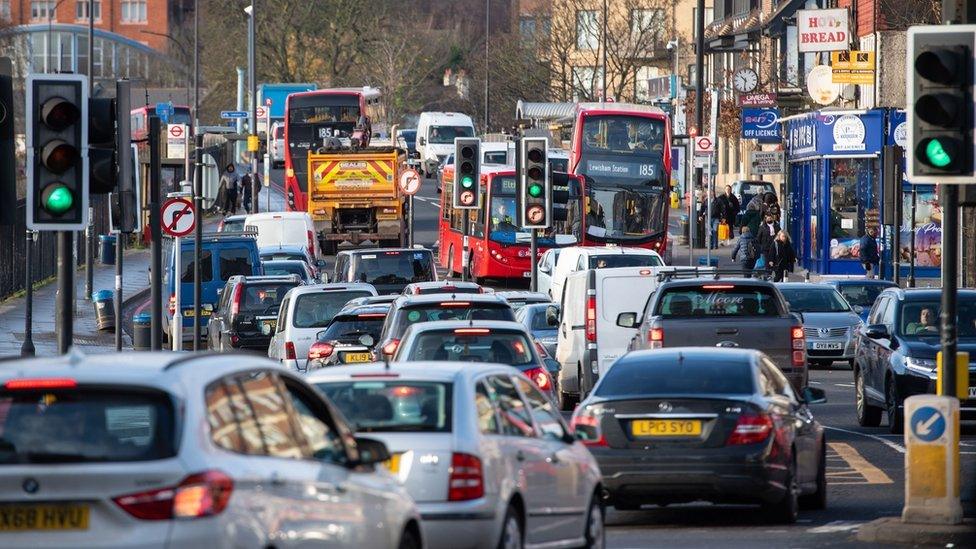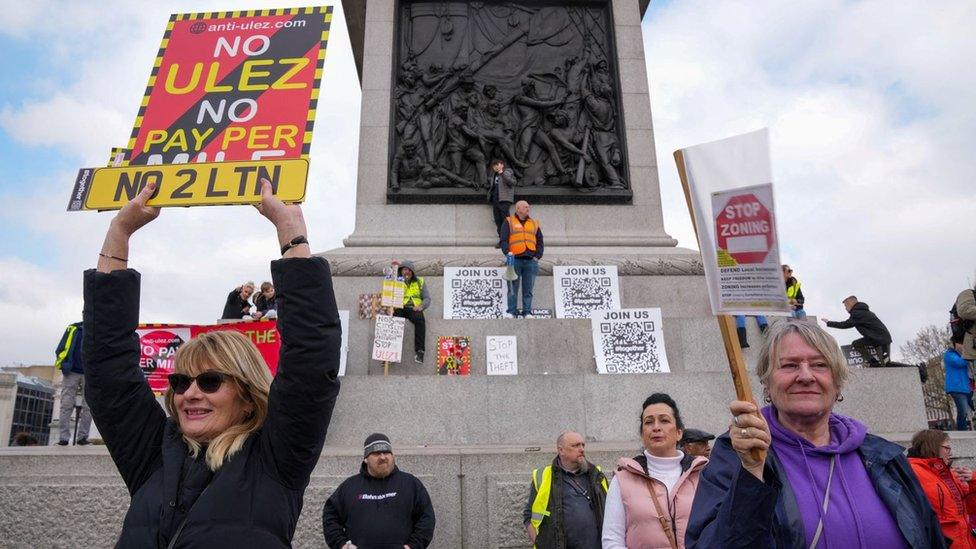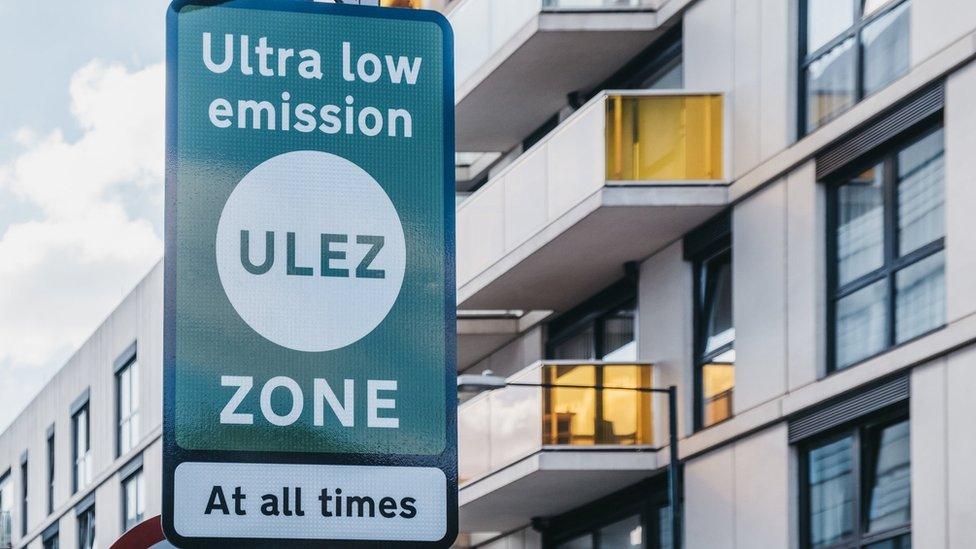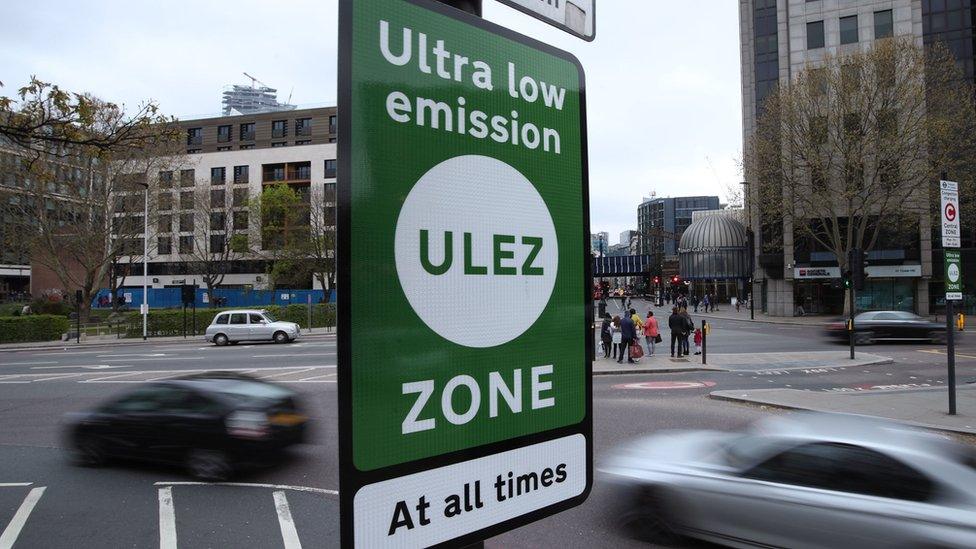Illegal levels of air toxins found in many boroughs

At a glance
Levels of the toxin nitrogen dioxide (NO2) in the air at five or more locations in 14 London boroughs were found to exceed the UK legal limit of 40 µg/m3 during tests
In total, sites in 31 boroughs had levels of the pollutant that exceeded the recommended limit set by the World Health Organisation
The single highest concentration of NO2 was found at Harlesden High Street
The mayor of London believes the study results make the case for the controversial expansion of the Ultra Low Emission Zone
- Published
Levels of the toxin nitrogen dioxide (NO2) in the air across 14 London boroughs were found to exceed the UK legal limits, according to a new study from City Hall.
The single highest level - of almost three times the legal limit - was found in Brent, on Harlesden High Street.
Air quality tests carried out across London also found levels of the toxin broke a recommended limit set by the World Health Organisation (WHO).
London mayor Sadiq Khan said the data was "shocking proof" that air quality was a problem "in every single part of the capital".

The mayor of London says the results prove the case for expanding the Ultra Low Emission Zone to cover the whole of Greater London
The study, external included results of testing carried out at 1,823 locations across 31 London boroughs throughout 2021.
London's councils are required to monitor air pollutants in their boroughs each year.
The data could not be compared with previous years as this was the first time an entire dataset hds been compiled and analysed, City Hall said.
The results revealed:
The WHO's recommended limit of nitrogen dioxide (10 µg/m3) was exceeded at all 1, 823 locations tested across 31 boroughs
A UK legal limit (40 µg/m3) was exceeded in five or more locations in 14 boroughs: Brent, The City of London, Croydon, Ealing, Greenwich, Hammersmith & Fulham, Hackney, Havering, Kensington & Chelsea, Lambeth, Merton, Richmond, Southwark and Wandsworth
In total, illegal levels of NO2 were found at one of more sites in 26 boroughs
The locations with the highest concentration of nitrogen dioxide were Harlesden High Street, Romford Town Centre and Wembley High Road
However, the number of sites tested within each borough varied significantly - 131 were measured in Newham, while just 15 were tested in Barnet.
Two boroughs, Bexley and Harrow, did not contribute to the study. Bexley Council said the results would not have been representative due to the Covid-19 pandemic and the cost of testing would have of "very limited use and a poor use of the public purse".
It says it will undertake the tests in 2024 and that it works towards UK laws rather than WHO guidelines.
According to City Hall, the results show similar average pollution concentration in inner and outer London, supporting the case to expand the Ultra Low Emission Zone (ULEZ).
The scheme, which charges drivers of the most polluting cars £12.50 a day to enter, is to be extended from August to cover the whole of Greater London.
“This data is yet more shocking proof that London’s air quality has been in serious breach of the recognised global standard - and it’s a problem in every single part of the capital," Mr Khan said.
“This is why I made the difficult decision to expand the ULEZ London-wide - to help save lives and to give all Londoners the right to breathe cleaner air.”
Five conservative councils in and around London are to take legal action later this year, in an attempt to stop the expansion.
Among them is Bexley Council, which did not carry out the tests for NO2 emissions for this study.
Tony Devenish AM, City Hall Conservatives environment spokesperson, said the expansion would have a "negligible" effect on air quality and a "devastating impact on low-income families, businesses and charities".

Analysis
By Tom Edwards, BBC London transport & environment correspondent
One of the arguments used by those against ULEZ expansion is that it isn’t needed as air pollution isn’t that bad in outer London.
Well this latest data published by the mayor is another attempt to prove that it is - in what is becoming an increasingly febrile and political information war.
This data is actually collated and reported by the London Boroughs themselves (although 2 didn’t participate) and it confirms what health experts have said for a long time - that WHO limits are breached everywhere in the capital.
And while WHO limits are lower than the UK’s legal limits, it’s important to remember health experts say there is no proven safe level of pollution.
And while this probably won’t change the minds of those who think ULEZ expansion isn’t needed, it could give more ammunition to those who argue that urban environments are no place for older, more polluting vehicles.

Follow BBC London on Facebook, external, Twitter, external and Instagram, external. Send your story ideas to hellobbclondon@bbc.co.uk, external
Related topics
More on London pollution
- Published24 April 2023

- Published14 April 2023

- Published4 August 2023

- Published24 January 2023
